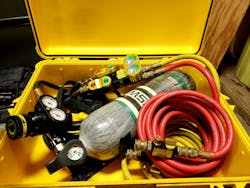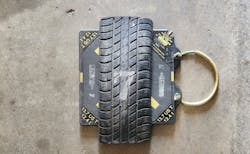Technical Rescue: Air Lifting Bag Tips and Tricks
A valuable part of any fire department’s rescue cache, high-pressure air lifting bags often only are partially understood by members. Many firefighters are familiar with identifying and assembling the parts of an air lifting bag system, but they might not fully understand their use.
Lifting with multiple air bags
There are two options for conducting a lift with multiple air bags: stacking and tandem. The amount of space that’s available, the amount of lift that’s needed, air lifting bag capacity and center of gravity, among other factors, influence whether rescuers choose to conduct a stacked or tandem lifting operation.
Stacked air lifting bags provide the greatest lift height, but the load that can be lifted is limited to the capacity of the smallest inflated bag.
Tandem lifting operations—air lifting bags that are placed side by side—allow rescuers to maximize the lifting capacity of their system by adding together the rated capacities for the bags that are used. Because different sizes of air lifting bags have different lifting capacities, dimensions and air requirements, using different size bags in a tandem lift can make an otherwise smooth and even lift difficult, if not impossible. To remedy this complication, many departments purchase matched sets of air lifting bags.
Never stack more than two air lifting bags unless the manufacturer of the bag specifically allows it. If using different size bags, always place the smaller bag on top of the larger one. If space permits, align stacked bags so the fittings are located on opposite sides, for easier tracking of top versus bottom bag.
Keep in mind that on level ground, unless you are lifting the entire object completely off of the ground, you never will lift more than half of the object’s weight. This is known as a hinged lift, and understanding this concept can help rescuers to develop a lifting plan for an extremely heavy load that utilizes their available equipment in the absolute best way possible.Air bag protection
Despite the reinforced construction of modern air lifting bags, rescuers still should take precautions to protect the bags from physical, thermal, mechanical and chemical damage. Options for bag protection, or bag pro, include plywood, sections of old supply hose, mud flaps and sections of conveyor belt. Rescuers should have multiple bag pro options available, because different situations might require different techniques, and the space that’s available in a particular scenario might not permit the use of some techniques.
One inexpensive and durable option for bag pro is tire tread. Using tire treads allows for full contact with both the air lifting bag and object that’s to be lifted. It also mates securely with the bag, which minimizes the chance of kickout or unintended movement, and provides additional protection via the steel belting that’s found in tires.
To make a tire tread bag pro, cut both sidewalls off of the tire. Using spring clamps or a vise to hold the tread, cut the tread into four equal size pieces. Use a grinder, file or other means to remove the wires that protrude from where the tread was cut, to prevent injuries.
Maximum lift height
Many rescuers aren’t familiar with the height limitations of air lifting bags and the potential damage and instability of the load that can be done by overinflating a bag. Although manufacturers provide the maximum inflation height for each specific bag, most departments don’t keep their equipment manuals on the apparatus. However, as a general rule, an air lifting bag never should be inflated to a height that exceeds half of its shortest side. For example, a 24 x 24-inch airbag never should be inflated to more than 12 inches tall.
Cold-weather operations
All modern air lifting bag systems are designed to operate in a wide range of temperatures. However, some steps prevent problems in extremely cold weather.
First, because air lifting bags typically are more resistant to cold temperatures than are the PVC hoses that are commonly used in their systems, fully uncoil and stretch out all of the hoses. If this step isn’t taken on scene in extreme temperatures, the hoses might freeze in a coiled configuration. This circumstance would prevent rescuers from fully extending the hoses to the location that’s needed.
Second, ensure that the surface on which the air lifting bags will be placed is free of ice or snow, to prevent unintended movement. If salt, antifreeze or other materials were used to help to remove ice or snow, ensure that the bottom of the bag is protected.
Consideration also should be given by members to the effects of cold on regulators, controllers and shutoffs/relief valves. Regardless of weather conditions, it always is good practice to have a backup set of equipment available, whether on your rig or through mutual aid. This is particularly important for air lifting bag operations in cold weather.
At one recent incident, an air lifting bag controller froze and was inoperable. Fortunately, the replacement controller was kept warm and, thus, functional inside of the turnout coat of the rescuer who was operating the system. By having a second bag controller immediately available, rescue operations were able to continue without delay.
Additionally, locking collars that are on fittings, shutoff valves, etc., might freeze in position, which would prevent them from being disconnected or portions of the system from being isolated.Alternative air bag drills
Unsurprisingly, one of the most frequent uses of air lifting bags is rescuing victims from beneath a vehicle. Therefore, this is the most frequent air lifting bag training scenario. However, many other air lifting bag drills, which range from simple to complex, can be implemented for trainings to improve the knowledge and skills of rescuers.
Rather than always lifting junk automobiles during extrication training, reach out to other departments and local partners, such as construction companies and arborists/tree services, to obtain jersey barriers, large sections of trees, scrap steel, 40-yard dumpsters, large trucks, heavy equipment, etc. Training drills that involve objects of varying shapes and weights help rescuers to gain experience in using air lifting bags in load assessment, predicting movement, stabilization and problem-solving.
Jake Hoffman will present “The Rescue Mindset” and “Rescue Company Tips and Tricks” at Firehouse Expo. To register, visit firehouseexpo.com.
Air Lifting Bag Construction/Care/Inspection
Air Lifting Bag Box
To minimize setup time on a rescue incident, all air lifting bag system components should be stored together. One way to accomplish this is by mounting an SCBA bracket inside of a large Pelican case. This case holds a 30-minute SCBA cylinder with the regulator attached, the airbag controller, hoses and shutoff/relief valves. To set up the air lifting bags, a rescuer only needs to open the box, turn on the cylinder and extend the hoses.
Rescue Cheat Sheets
About the Author

Jake Hoffman
Jake Hoffman is a private with the Toledo, OH, Fire & Rescue Department who is assigned to Rescue Squad 7. He has spent time assigned to both the Special Operations Bureau and the Training Bureau. Hoffman is a HAZMAT team manager with the Ohio-Task Force 1 Urban Search and Rescue Team. He is a co-owner of Squad 5 Fire Training.


